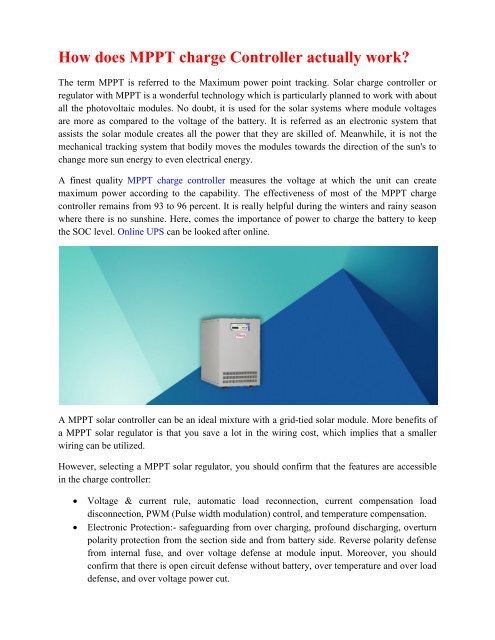You also want an ePaper? Increase the reach of your titles
YUMPU automatically turns print PDFs into web optimized ePapers that Google loves.
<strong>How</strong> <strong>does</strong> <strong>MPPT</strong> <strong>charge</strong> <strong>Controller</strong> <strong>actually</strong> <strong>work</strong>?<br />
The term <strong>MPPT</strong> is referred to the Maximum power point tracking. Solar <strong>charge</strong> controller or<br />
regulator with <strong>MPPT</strong> is a wonderful technology which is particularly planned to <strong>work</strong> with about<br />
all the photovoltaic modules. No doubt, it is used for the solar systems where module voltages<br />
are more as compared to the voltage of the battery. It is referred as an electronic system that<br />
assists the solar module creates all the power that they are skilled of. Meanwhile, it is not the<br />
mechanical tracking system that bodily moves the modules towards the direction of the sun's to<br />
change more sun energy to even electrical energy.<br />
A finest quality <strong>MPPT</strong> <strong>charge</strong> controller measures the voltage at which the unit can create<br />
maximum power according to the capability. The effectiveness of most of the <strong>MPPT</strong> <strong>charge</strong><br />
controller remains from 93 to 96 percent. It is really helpful during the winters and rainy season<br />
where there is no sunshine. Here, comes the importance of power to <strong>charge</strong> the battery to keep<br />
the SOC level. Online UPS can be looked after online.<br />
A <strong>MPPT</strong> solar controller can be an ideal mixture with a grid-tied solar module. More benefits of<br />
a <strong>MPPT</strong> solar regulator is that you save a lot in the wiring cost, which implies that a smaller<br />
wiring can be utilized.<br />
<strong>How</strong>ever, selecting a <strong>MPPT</strong> solar regulator, you should confirm that the features are accessible<br />
in the <strong>charge</strong> controller:<br />
<br />
<br />
Voltage & current rule, automatic load reconnection, current compensation load<br />
disconnection, PWM (Pulse width modulation) control, and temperature compensation.<br />
Electronic Protection:- safeguarding from over charging, profound discharging, overturn<br />
polarity protection from the section side and from battery side. Reverse polarity defense<br />
from internal fuse, and over voltage defense at module input. Moreover, you should<br />
confirm that there is open circuit defense without battery, over temperature and over load<br />
defense, and over voltage power cut.


















